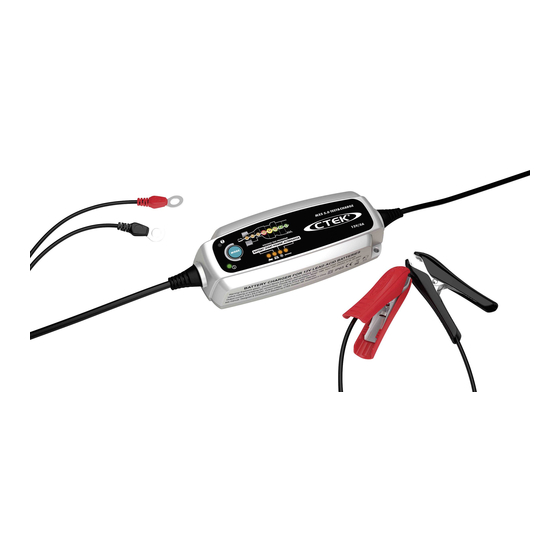
Advertisement
Quick Links
Advertisement

Summarization of Contents
Charger Capabilities and Basic Functions
Lithium Battery Charging and Temperature Sensors
Inquire about lithium battery charging and temperature compensation.
Charger Behavior and Fault Indicators
Understand clicking sounds, lamp patterns, and step progression.
Charger Programs and Usage Scenarios
Understanding Charger Modes and Symbols
Explains RECOND program and charger symbol meanings.
Vehicle Compatibility and Charging Practices
Discusses start/stop vehicles, charging while used, and maintenance.
Connecting, Programming, and Charging Process
Charger Connection and Program Selection
Guidance on connecting the charger and choosing the right program.
Monitoring and Interrupting Charging
How to know when charged, charging duration, and safety of interruption.
Troubleshooting Charger Faults and Errors
Charger Not Reaching Final Step or Step 4
Explains reasons for not completing charge cycle or reaching specific steps.
Error Lamp and Power Issues
Diagnosing error lamps and power connection problems.
Vehicle Integration and Charger Sizing
Vehicle Connection and Usage Guidelines
Charging with vehicle running, long-term connection, and 12V socket use.
Battery Charger Sizing and Connection Advice
Choosing the right charger size and connection methods.
Advanced Charging Scenarios and Battery Types
Charger Behavior and Heat Generation
Charging without removal, float stage, and normal heating.
Battery Types and Connection for BMS
Charging lithium/lead-acid batteries, and BMS connection.
Long-Term Use, Errors, and Technical Details
Error Mode and Maintenance Charging
Handling error mode and confirming long-term maintenance.
LED Indicators and Power Issues
Troubleshooting LED status and power connection issues.
Understanding Ripple in Charging
Explains ripple and its effect on batteries and electronics.
Charger Selection and Energy Consumption
Factors for Choosing a CTEK Charger
Key considerations when selecting a CTEK charger.
Energy Calculation for Lead-Acid Batteries
Method to calculate energy expenditure for charging.
Battery Types and Advanced Charging
Battery Size and Condition Considerations
Handling larger batteries, deep discharge, and frozen batteries.
GEL, Frozen, and Multiple Battery Charging
Charging GEL, frozen, and multiple batteries.
Charger Settings and Compatibility
Charger Sizing and AGM Battery Mode
Using larger chargers and AGM battery mode selection.
Troubleshooting Mode Button and Settings Memory
Addressing issues with mode selection and power loss memory.
Long-Term Maintenance and System Compatibility
Unattended Charging and Maintenance Switch
Guidance on leaving chargers unattended and maintenance switching.
Multi-Battery Systems and Other Types
Charging 24V systems and other battery types.
Multiple Batteries and Safe Connections
Connecting Multiple Batteries Safely
Advice on charging multiple batteries and using Y-cables.
Negative Connection and Grounding
Proper grounding procedures for vehicle connections.
General Charger Information and Usage
Charger Design and Long-Term Use
Galvanic separation, long-term connection, and warmth.
Charger Sizing and Battery Removal
Selecting charger size and charging without battery removal.
Troubleshooting and Battery Terminology
Charger Start-up Issues and Lithium Charging
Diagnosing start issues and charging lithium batteries.
Understanding Battery Types (AGM, EFB, CA/CA)
Definitions and characteristics of different battery types.
Battery Types and Charger Modes
Definitions of Battery Chemistries
Explains WET/FLOODED, MF/VRLA, GEL, SPIRAL CELL, LiFePo4.
Normal and Supply Charging Modes
Details on NORMAL and SUPPLY modes for chargers.
Specific Charging Modes and Processes
BOOST, RECOND, and AGM/SNOWFLAKE Modes
Explains BOOST, RECOND, and AGM/SNOWFLAKE charging modes.
CACA, DESULPHATION, and STRATIFICATION
Details on CACA mode, desulphation, and stratification.
Charging Stages and Indicators
BULK, ABSORPTION, FLOAT, and PULSE Stages
Defines the stages of the charging process.
Understanding SoC and Buzzing Sounds
Explains State of Charge (SoC) and buzzing sounds.
Continued Usage and Connection Guidelines
Charging with Motor Heaters and Battery Use
Charging with motor heaters and using battery during charging.
Pulse Maintenance and Connection Methods
Reasons for not reaching pulse mode and connection options.
Charger Selection and Long-Term Use
Determining Suitable Charger Size
Guidance on selecting the correct charger size based on battery.
Long-Term Battery Connection
Best practices for leaving the charger connected long-term.
















Need help?
Do you have a question about the 56-959 T&C and is the answer not in the manual?
Questions and answers